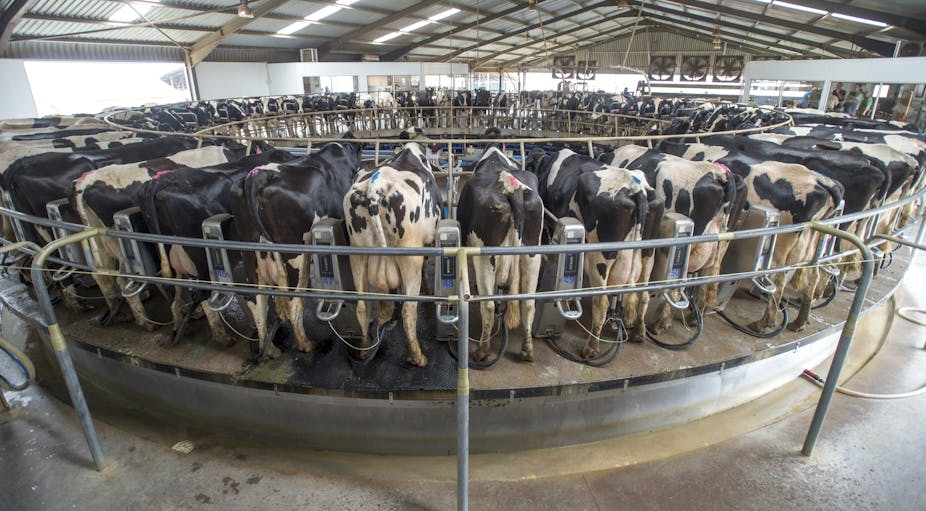Few countries have had to deal with the scale of animal disease outbreaks South Africa has had to. Getty Images
South Africa has had a number of outbreaks of animal diseases in recent months that suggest there are weaknesses in the country’s biosecurity system – the measures in place to reduce the risk of infectious diseases being transmitted to crops, livestock and poultry.
The outbreaks pose a major challenge for South Africa’s domestic animal farming sector. Fears of weaknesses in the system have been raised by agribusiness for some time, suggesting that pressures and concerns are mounting.
Biosecurity breaches are not unique to South Africa. They have become a significant challenge globally. It’s not easy to put a monetary figure on it, but reports of disease outbreaks across the world, and indeed in South Africa, suggest the problem has intensified.
In South Africa, reports about foot-and-mouth disease in cattle, African swine fever in pigs and avian influenza in poultry have become frequent. But few countries have had to deal with these disease outbreaks almost simultaneously, as South Africa has.
In 2022, six of South Africa’s nine provinces reported foot-and-mouth disease outbreaks. This was the first time in the country’s history that the disease had been spread this wide.
The situation remains critical.
All these outbreaks have had a notable impact on South African agricultural exports, and the growth prospects of the sector. For example, South Africa’s beef exports for 2022 were down by 12% year-on-year, according to data from Trade Map. This decline was primarily due to the temporary closures of various export markets following the outbreak of foot-and-mouth disease in South Africa. Farmers are being hit hard.
Livestock and poultry account for roughly half of agriculture’s gross value added.
Based on this history and the experiences of the agricultural sector, there is concern that South Africa’s biosecurity breaches signal serious capacity challenges in farm biosecurity measures and the country’s veterinary and related support services (mainly the laboratories) that control the movement of livestock and vaccine production.
The South African government, organised agriculture and industry bodies should work together closely to address the country’s biosecurity challenges.
Disease outbreaks
On 4 November this year, the Department of Agriculture, Land Reform and Rural Development announced it was investigating a suspected outbreak of foot-and-mouth disease in one district.
This means the issue that was identified a year ago remains a challenge. These outbreaks weigh heavily on the cattle industry’s fortunes. The beef industry accounts for a sizable share of the South African agricultural economy, and is positioned to absorb new entrant farmers in the sector. Beef exports were about 1% of agricultural exports, valued at US$151 million, in 2022, according to Trade Map.
The sheep industry was also affected by the 2022 outbreak. China, a significant market for South African wool, suspended imports. This resulted in a 21% year-on-year decline in the export value of wool in 2022, to US$337 million, according to Trade Map data. Wool still made up 3% of South Africa’s record agricultural export value of US$12.8 billion in 2022.
China’s official reason for the suspension was the foot-and-mouth disease outbreak. But it might not be all that clear cut. China may also have had capacity issues at its ports at the time because of the tail-end effects of COVID-19 and the restrictions there.
China has a unique protocol to handle wool shipments and avoid any contamination during a foot-and-mouth disease outbreak in South Africa. This was agreed in 2019 after an outbreak.
In 2022 South Africa’s pig industry was put under fresh pressures. Towards the end of the year outbreaks of African swine fever were reported. The disease remains a challenge.
Most recently, the focus has been on avian influenza. More than a hundred commercial poultry facilities have reported cases. There are major losses for breeders of layers and broilers. As a result, there has been a spike in imports of fertilised eggs to rebuild the parent stock flock. This is key for stabilising the industry.
Major producers have announced serious losses. Consumers are also seeing a rise in the price of eggs.
Policy considerations
The growth prospects of farming businesses remain at risk if there are no material improvements in biosecurity. This is particularly true for sub-sectors that are crucial for inclusive growth. For example, the National Agricultural Marketing Council estimates suggest that black farmers account for 18%, 13% and 34% of wool, mohair and cattle production, respectively.
The department of land and agriculture should consider earmarking a share of its annual budget for emergencies to deal with biosecurity risks. These funds should be used only in the case of notifiable animal disease outbreaks and under strict rules and in concurrence with the South African National Treasury. This will be necessary to control animal movements, procure vaccines and permit vaccination in certain areas, employ additional staff and compensate producers when animals must be culled.
Notably, the government should also work the private sector on vaccine manufacturing as national laboratories have experienced failures in the recent past, thus weakening disease control efforts. Additionally, government should increase the number of veterinarians and animal health technicians.
Also necessary is the repair and maintenance of international fences, which fail to keep wild animals and infected animals from neighbouring countries out of South Africa. Collaboration between Public Works and the National Treasury in this respect is critical.
In essence, most interventions require better management, coordination, restructuring of departments, and investment in fencing, new laboratory equipment and vaccine production.
Beyond the technical matters, the relationship between the regulators and farmers should also be improved so that disease outbreaks can be managed collaboratively with no hostility.![]()
Wandile Sihlobo, Senior Fellow, Department of Agricultural Economics, Stellenbosch University
This article is republished from The Conversation under a Creative Commons license. Read the original article.


